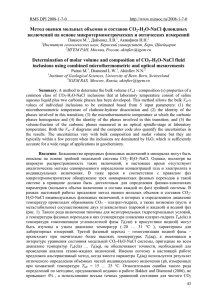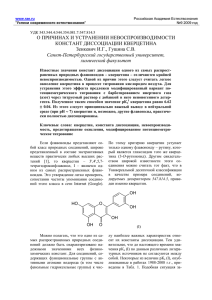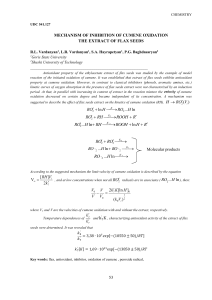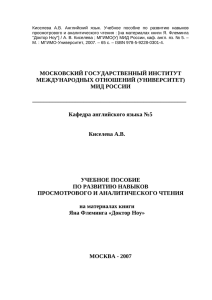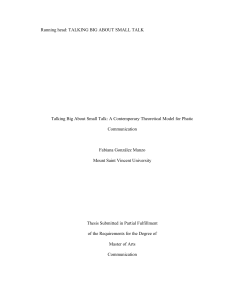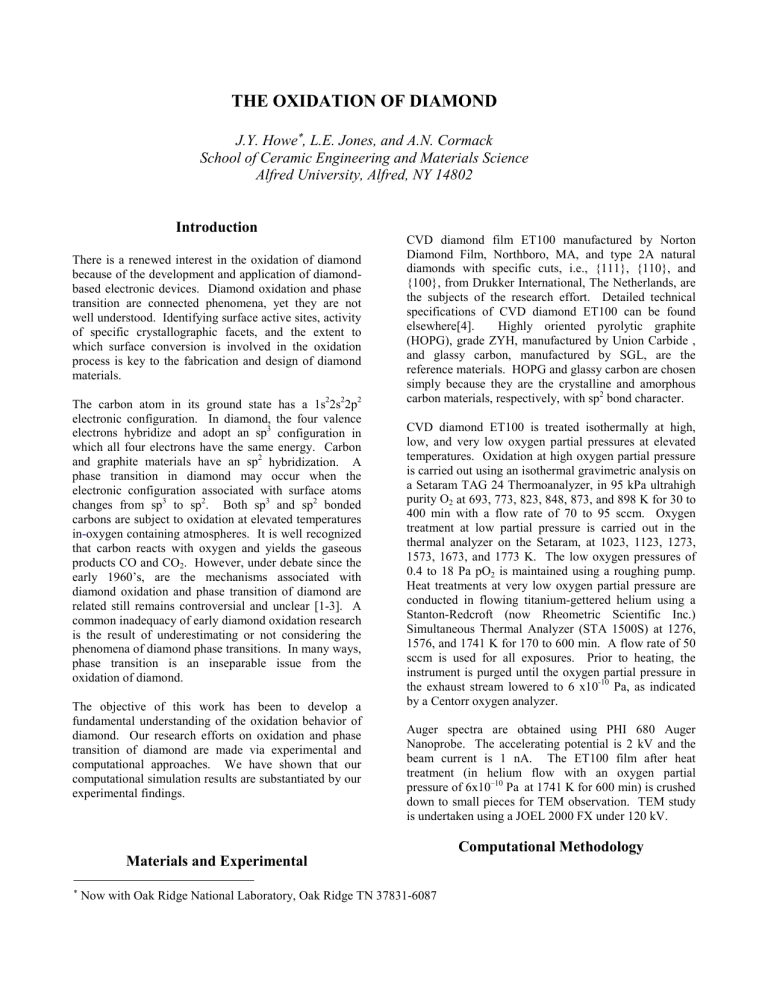
THE OXIDATION OF DIAMOND
J.Y. Howe∗, L.E. Jones, and A.N. Cormack
School of Ceramic Engineering and Materials Science
Alfred University, Alfred, NY 14802
Introduction
There is a renewed interest in the oxidation of diamond
because of the development and application of diamondbased electronic devices. Diamond oxidation and phase
transition are connected phenomena, yet they are not
well understood. Identifying surface active sites, activity
of specific crystallographic facets, and the extent to
which surface conversion is involved in the oxidation
process is key to the fabrication and design of diamond
materials.
The carbon atom in its ground state has a 1s22s22p2
electronic configuration. In diamond, the four valence
electrons hybridize and adopt an sp3 configuration in
which all four electrons have the same energy. Carbon
and graphite materials have an sp2 hybridization. A
phase transition in diamond may occur when the
electronic configuration associated with surface atoms
changes from sp3 to sp2. Both sp3 and sp2 bonded
carbons are subject to oxidation at elevated temperatures
in-oxygen containing atmospheres. It is well recognized
that carbon reacts with oxygen and yields the gaseous
products CO and CO2. However, under debate since the
early 1960’s, are the mechanisms associated with
diamond oxidation and phase transition of diamond are
related still remains controversial and unclear [1-3]. A
common inadequacy of early diamond oxidation research
is the result of underestimating or not considering the
phenomena of diamond phase transitions. In many ways,
phase transition is an inseparable issue from the
oxidation of diamond.
The objective of this work has been to develop a
fundamental understanding of the oxidation behavior of
diamond. Our research efforts on oxidation and phase
transition of diamond are made via experimental and
computational approaches. We have shown that our
computational simulation results are substantiated by our
experimental findings.
CVD diamond film ET100 manufactured by Norton
Diamond Film, Northboro, MA, and type 2A natural
diamonds with specific cuts, i.e., {111}, {110}, and
{100}, from Drukker International, The Netherlands, are
the subjects of the research effort. Detailed technical
specifications of CVD diamond ET100 can be found
elsewhere[4].
Highly oriented pyrolytic graphite
(HOPG), grade ZYH, manufactured by Union Carbide ,
and glassy carbon, manufactured by SGL, are the
reference materials. HOPG and glassy carbon are chosen
simply because they are the crystalline and amorphous
carbon materials, respectively, with sp2 bond character.
CVD diamond ET100 is treated isothermally at high,
low, and very low oxygen partial pressures at elevated
temperatures. Oxidation at high oxygen partial pressure
is carried out using an isothermal gravimetric analysis on
a Setaram TAG 24 Thermoanalyzer, in 95 kPa ultrahigh
purity O2 at 693, 773, 823, 848, 873, and 898 K for 30 to
400 min with a flow rate of 70 to 95 sccm. Oxygen
treatment at low partial pressure is carried out in the
thermal analyzer on the Setaram, at 1023, 1123, 1273,
1573, 1673, and 1773 K. The low oxygen pressures of
0.4 to 18 Pa pO2 is maintained using a roughing pump.
Heat treatments at very low oxygen partial pressure are
conducted in flowing titanium-gettered helium using a
Stanton-Redcroft (now Rheometric Scientific Inc.)
Simultaneous Thermal Analyzer (STA 1500S) at 1276,
1576, and 1741 K for 170 to 600 min. A flow rate of 50
sccm is used for all exposures. Prior to heating, the
instrument is purged until the oxygen partial pressure in
the exhaust stream lowered to 6 x10-10 Pa, as indicated
by a Centorr oxygen analyzer.
Auger spectra are obtained using PHI 680 Auger
Nanoprobe. The accelerating potential is 2 kV and the
beam current is 1 nA. The ET100 film after heat
treatment (in helium flow with an oxygen partial
pressure of 6x10–10 Pa at 1741 K for 600 min) is crushed
down to small pieces for TEM observation. TEM study
is undertaken using a JOEL 2000 FX under 120 kV.
Computational Methodology
Materials and Experimental
∗
Now with Oak Ridge National Laboratory, Oak Ridge TN 37831-6087
Computer simulation is carried out using CASTEP codes
on an SGI Octane work station. CASTEP, an acronym
for CAmbridge Sequential Total Energy Package, is a
commercial software package originally developed by
the Theory of Condensed Matter Group at the University
of Cambridge, England [5]. It performs total energy
calculations that solve quantum mechanical equations for
the electronic states of systems containing arbitrary
arrangements of atoms using density functional theory.
CASTEP calculations are carried out on periodically
repeating cells or boxes, usually referred to as
“supercells”. The dimension of the supercell may be the
same as the unit cell. It can also be set to be larger than
the unit cell. Supercells can host not only crystalline
species, but also species without periodicity, e.g., an
oxygen molecule. The simulation strategy in the current
study is to build a supercell with various surface
conditions and perform a geometry optimization with
respect to the total energy. The cell is built to be large
enough to allow relaxation, yet small enough to be
computationally economical (smaller cells demand less
CPU time, therefore, use fewer computational resources).
Giving as an example, in order to study the surface
relaxation and oxygen-chemisorption, a cell of 54 carbon
atoms in total is built with six (111) layers; each layer
contains 9 carbon atoms, (see Figure 1). There is 10 Å
of vacuum on top of the (111) surface. Thus, an infinite
3-D lattice is constructed in a way that it can also be
visualized as stacks or slabs (infinite in 2-D) with 10Å of
vacuum in between. The vacuum space of 10 Å is large
enough to ensure that there are no interactions between
adjacent slabs. The (110) and (100) supercells are
constructed in a similar manner. These supercells are the
templates on which chemisorbed species, mostly oxygen
in the current study, can be deliberately added to the top
layer. Geometry optimization is then performed on these
starting models. The calculations are performed using
GGA-PW91 method (general gradient approximation,
the Perdew-Wang method) [6, 7]
Results and Discussions
Although the main Auger peak, carbon KVV, is similar
for all the carbon materials, the difference of bond
character, sp2 vs sp3, can be sought from the first satellite
peak in the vicinity of 255 and 265 eV[8-11]. Figure 2
contains the Auger spectra collected from CVD diamond
ET100 and glassy carbon. The spectra of diamond
treated at 823 K/95 kPa O2 is quite similar to that of the
as-received specimen. The similarity of line shapes
between as-received and oxidized diamonds implies that
a direct oxidation from of sp3-bond carbon without a
concurrent phase transition. In contrast, the spectrum of
diamond treated at a low oxygen pressure is similar to
that of the glassy carbon reference. The lower shoulder
at A1 is the significant feature of sp2-carbon. This clearly
shows that after heat treatment at 1741K in 6x10-10 Pa O2
for 600 min, the surface of diamond changes from sp3 to
sp2. In other words, oxidation occurs with a phase
transition under these conditions.
Figure 1. The diamond (111) supercell used as a
template for surface relaxation or chemisorption. The
10Å of vacuum space above the lattice planes simulates
the surface of diamond.
as-recieved
diamond
3
sp
high shoulder
at 1st satellite peak
A1
diamond
823 K
95 kPa O
A
0
2
2
sp
low shoulder
at 1st satellite peak
A0
A1
A0
260
diamond
1741 K
6x10 -10 Pa O
2
A0
240
glassy carbon
reference
280
300
kinetic energy (eV)
Fig. 2. Auger spectra of CVD diamond ET100 and
glassy carbon. Difference of bond character is shown in
the first satellite peak A1. Heat treatment in low oxygen
partial pressure leads to a surface reconstruction to sp2
bond character.
Clean Diamond (111) Surface
Clean surface refers to a surface that is free of any
adsorbed atoms. Figure 3 is the structure of clean
(diamond (111) surface after relaxation created via the
computational methodology described. Compared to the
starting structure shown in Figure 1, the kinked (111)
layers of the sp3 diamond have flattened and the
interlayer spacing has increased to 3.40 Å. This structure
is chemically analogous to the graphite structure.
Simulation studies show that surface reconstruction from
sp3 to sp2 bonding occurs on clean diamond (111)
surface. Experimentally, it is observed upon heat
treating CVD diamond film ET100 in low oxygen partial
pressures (less than 1 Pa) and temperatures higher than
1123 K, that the surface of diamond becomes black
supporting the model’s suggestion that a phase transition
to a surface sp2 layer occurs. Auger analysis indicates
that this black layer possesses an sp2 bond character. It
is further determined using TEM and electron diffraction
that this black layer of carbon is amorphous. Without
oxygen, diamond (111) surface reconstructs to
amorphous sp2-carbon.
However, simulation study
indicates that the clean diamond (110) and (100) surfaces
still keep retain their sp3 bond character under the same
conditions. This indicates that the (110) and (100)
surfaces are less subject to surface reconstruction, in
other words, more stable.
O-Chemisorbed (111) Surface
Figure 4 is the relaxed diamond (111) with one layer of
chemisorbed oxygen. On the supercell described in
Figure 1, there are 9 surface sites. A full oxygen
coverage refers to that all the sites are covered by
chemisorbed oxygen atoms. Fully oxygen-chemisorbed
diamond (111) surface maintains sp3 configuration.
There is no surface construction on (111) surface.
One might ask what would occur at low oxygen
pressures? Our simulation study suggests that diamond
(111) surface could convert to an sp2 bond character even
with the presence of small amount of oxygen, e.g., at low
oxygen surface coverage of 11 and 22% (a coverage of
11% is achieved by having one chemisorbed oxygen on
surface while 22% coverage is a surface with 2 oxygen
atoms.) Figure 5 is the relaxed diamond (111) surface
with 22% oxygen coverage. The structure is similar to
the clean surface shown in Figure 3. This finding is
consistent with the experimental results that diamond
experiences a surface phase transition to sp2 at oxygen
partial pressures ranged from 0.6 to 18 Pa at
temperatures of 1123 to 1773 K [12].
Computational study also reveals that with 67% Ocoverage, the diamond (111) surface becomes
amorphous but still has sp3 bond character. Oxidized in
95 kPa O2 at 823 K, the surface of CVD diamond ET100
has approximately 50% coverage[3, 12-14]. The Auger
spectrum of the surface indicates that the surface carbon
has an sp3 bond character, Figure 2.
Diamond (100) and (110) Surfaces
The (100) and (110) surfaces are less reactive as
compared to (111) surface. There is no drastic surface
reconstruction on these two surfaces. The clean surface
and the 100% oxygen coverage remain the retain their
sp3 bond character after relaxation. Our simulation
clearly shows that O-O single bonds could form on (110)
surface.
Figure 3. Relaxation of the clean diamond (111) surface
leads to a structure with sp2 bond character. The
interlayer spacing is 3.40 Å. Note the difference of the
structure as compared to Figures 1 and 5.
(Figure 4 is placed on the next page due to the large size)
Figure 5. Computer simulation: the sp3 bond character is
preserved if the surface is covered by chemisorbed
oxygen. Note the analogous as compared to Figure 1.
Part of the experimental work was conducted at Oak
Ridge National Laboratory, as part of the High
Temperature Materials Laboratory User Program,
sponsored by the U.S. Dept. of Energy under contract
DE-AC05-00OR22725.
References
Figure 6. Phase transition occurs on the diamond (111)
surface with 22% chemisorbed oxygen. The surface
carbon has an sp2 bond character.
Conclusions
Taking both oxidation and phase transition into
consideration, we propose that diamond can take either
one of two different paths during the heat treatment of
diamond in oxygen at elevated temperatures: 1) direct
gasification of sp3-bonded carbon; and 2) sp3 to sp2 phase
transition (surface reconstruction) first, then followed by
gasification of sp2-bonded carbon. Diamond oxidation
and phase transition are the results of these two
competing mechanisms. We further suggest that surface
oxygen coverage and temperature are the two most
influential factors that govern the surface reaction of
diamond. The reaction between oxygen and diamond
(111) surface at room pressure is summarized as:
• Elevated temperature (~ 973 K to 1773 K), zero
coverage:
The bond character of diamond (111) surface
changes from sp3 to sp2. Thus, diamond goes
through a phase transition and forms amorphous,
sp2-bonded carbon.
• Elevated temperature (~ 973 K and higher), low
coverage (up to 20%):
Diamond converts to amorphous, sp2-bonded carbon
first. Then the oxidation of carbon proceeds,
yielding gaseous products CO and/or CO2.
• Elevated temperature (~ 773 K and higher), high
coverage (more than 50%):
Diamond converts to amorphous, sp3-bonded carbon
first. Then the oxidation proceeds, yielding gaseous
products CO and/or CO2.
Acknowledgements
1. Evans T and Phaal C. The Kinetics of the DiamondOxygen Reaction. Proc. Conf. Carbon, 5th(1962); 1:147153.
2. Kern G and Hafner J. Ab Initio Molecular-Dynamics
Studies of the Graphitization of Flat and Stepped
Diamond (111) Surfaces. Phys. Rev. B: Condens. Matter
Mater. Phys.(1998); 58 (19):13167-13175.
3.
Gogotsi YG, Kailer A and Nickel KG.
Transformation of Diamond to Graphite. Nature(1999);
401 (6754):663-664.
4. Howe JY, Jones LE and Coffey DW. The Evolution
of Microstructure of CVD Diamond by Oxidation.
Carbon(2000); 38 (6):931-933.
5. C2-CASTEP. Molecular Simulations Inc.(2001);
http://www.msi.com/materials/cerius2/castep.html.
6. Perdew JP. Density-functinal Approximation for the
Correlation Energy of the Inhomogeneous Electron Gas.
Phys. Rev. B: Condens. Matter Mater. Phys.(1986); 33
(12):8822-8824.
7. Perdew JP and Zunger A. Self-interaction Correction
to Density-Functional Approximations for ManyElectron Systems. Phys. Rev. B: Condens. Matter Mater.
Phys.(1986); 23 (10):5048.
8. Lurie PG and Wilson JM. The Diamond Surface II.
Secondary Electron Emission. Surf. Sci.(1977); 65:476498.
9. Pate BB. The Diamond Surface: Atomic and
Electronic Structure. Surf. Sci.(1986); 165 (1):83-142.
10. Ramaker DE. Chemical Effects in the Carbon KVV
Auger Line Shapes. J. Vac. Sci. Technol., A(1989); 7
(3):1614-1622.
11. Howe JY, Jones LE and Braski DN. An Auger and
XPS Study on CVD and Natural Diamonds. Mater. Res.
Soc. Symp. Proc.(2000); 593:453-458.
12. Howe JY. The Oxidation of Diamond. Ph.D. Thesis,
Alfred University, Alfred, NY. (2001)
13. Matsumoto S, Kanda H, Sato Y and Setaka N.
Thermal Desorption Spectra of the Oxidized Surfaces of
Diamond Powders. Carbon(1977); 15 (5):299-302.
14. De Vita A, Galli G, Canning A and Car R.
Graphitization of Diamond (111) Studied by First
Principles Molecular Dynamics. Appl. Surf. Sci.(1996);
104/105:297-303.
Figure 4. TEM image and electron diffraction pattern of the carbon layer formed during the treatment of CVD diamond ET
100 at 1741 oC in 6x10-10 Pa O2 for 600 min. The blur diffraction rings at the corner suggest the amorphous nature of the
carbon layer.
